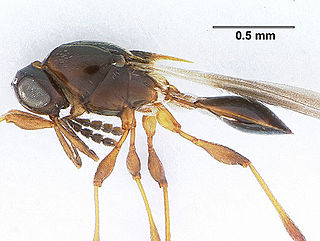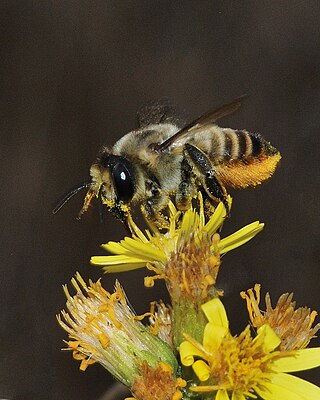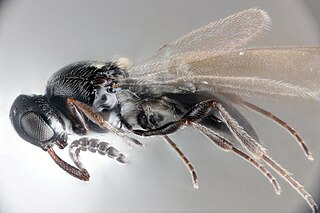
The Hymenopteran superfamily of parasitoid wasps, Platygastroidea, has often been treated as a lineage within the superfamily Proctotrupoidea, but most classifications since 1977 have recognized it as an independent group within the Proctotrupomorpha. It is presently has some 4000 described species. They are exclusively parasitic in nature.

The hymenopteran family Platygastridae is a large group of exclusively parasitoid wasps, mostly very small (1–2 mm), black, and shining, with geniculate (elbowed) antennae that have an eight-segmented flagellum. The wings sometimes lack venation, though they may have slight fringes of setae.

The genus Megachile is a cosmopolitan group of solitary bees, often called leafcutter bees or leafcutting bees; it also includes the called resin bees and mortar bees. While other genera within the family Megachilidae may chew leaves or petals into fragments to build their nests, certain species within Megachile neatly cut pieces of leaves or petals, hence their common name. This is one of the largest genera of bees, with more than 1500 species in over 50 subgenera. The alfalfa leafcutter bee is managed on a commercial scale for crop pollination, and has been introduced by humans to various regions around the world.
Calliscelio is a parasitoid wasp genus which contains two species, C. elegans and C. teleogrylli.
Anteris is a genus of wasps in the family Platygastridae. There are about 15 described species in Anteris.
Oethecoctonus oecanthi is a species of parasitoid wasp in the family Platygastridae.
Synopeas hopkinsi is a species of parasitoid wasp in the family Platygastridae.
Synopeas is a genus of parasitoid wasps in the family Platygastridae. There are about 400 described species in Synopeas.
Oethecoctonus is a genus of parasitoid wasps in the family Platygastridae. There are about six described species in Oethecoctonus.

Scelioninae is a subfamily of wasps in the family Platygastridae. It is a very large cosmopolitan group of exclusively parasitoid wasps, mostly small (0.5–10 mm), often black, often highly sculptured, usually with geniculate (elbowed) antennae that have a 9- or 10-segmented flagellum. It was formerly considered to be a family Scelionidae but has been reclassified as a subfamily of the Platygastridae.

Teleasinae is a subfamily of wasps in the family Platygastridae. There are about 14 genera and more than 250 species in Teleasinae.
Platygaster rubi is a species of parasitoid wasp in the family Platygastridae.
Metaclisis floridana is a species of parasitoid wasp in the family Platygastridae.
Metaclisis is a genus of parasitoid wasps in the family Platygastridae. There are at least 30 described species in Metaclisis.
Macroteleia carinata is a species of parasitoid wasp in the family Platygastridae.

Macroteleia is a genus of parasitoid wasps in the family Platygastridae. There are more than 140 described species in Macroteleia.
Scelio floridanus is a species of parasitoid wasp in the family Platygastridae.
Platygaster munita is a species of parasitoid wasp in the family Platygastridae. It is found in Europe.
Trichacis virginiensis is a species of parasitoid wasp in the family Platygastridae.

Trichacis is a genus of parasitoid wasps in the family Platygastridae. Members of this genus have a tuft of setae on the mesoscutellum and transverse striae or rugulae above the antennae. They are parasitoids of Cecidomyiidae, although the hosts of most species remain unknown.










